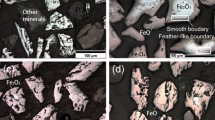Abstract
Hematite with different particle sizes was obtained through isothermal annealing and mechanochemical ball-milling methods. The hematite phase is very stable under air atmosphere. The thermal stabilities of hematite under argon atmosphere were characterized by thermal analysis studies up to 800 °C using a simultaneous DSC–TG technique. The lattice parameters a and c of hematite with different particle sizes were extracted from the Rietveld structural refinement of powder X-ray diffraction patterns. Decomposition of hematite into a lower oxidation state in inert argon atmosphere was studied by the TG experiments for the first time and the enthalpy associated with the decomposition reaction was determined from the DSC studies. Particle size has a strong effect on the thermal behavior of hematite samples. Ball-milled hematite samples with smaller particle size showed that the phase transformation was extended to higher temperature range with larger enthalpy. Hematite with larger average particle size showed higher stability under argon atmosphere.





Similar content being viewed by others
References
Wang GX, Gou XL, Horvat J, Park J. Facile synthesis and characterization of iron oxide semiconductor nanowires for gas sensing application. J Phys Chem C. 2008;112:15220–5.
Raffaella B, Etienne S, Cinzia G, Fabia G, Mar GH, Miguel AG, Roberto C, Pantaleo DC. Colloidal semiconductor/magnetic heterostructures based on iron-oxide-functionalized brookite TiO2 nanorods. Phys Chem Chem Phys. 2009;11:3680–91.
Winter G. Anorganic pigments: dispersed festkörper mit technisch verwertbaren optischen und magnetischen eigenschaften. Fortschr Miner. 1979;57:172–202.
Krishnamoorthy S, Rivas JA, Amiridis MD. Catalytic oxidation of 1,2-dichlorobenzene over supported transition metal oxides. J Catal. 2000;193:264–72.
Sorescu M, Diamandescu L, Tomescu A, Tarabasanu-Mihaila D, Teodorescu V. Structure and sensing properties of 0.1SnO2–0.9-Fe2O3 system. Mater Chem Phys. 2008;107:127–31.
Laberty C, Navrotsky A. Energetics of stable and metastable low-temperature iron oxides and oxyhydroxides. Geochim Costmochim Acta. 1998;62:2905–13.
Greedan JE. Magnetic oxides. In: King RB, editor. Encyclopedia of inorganic chemistry. New York: Wiley; 1994.
Bernal JD, Dasgupta DR, Mackay AL. The oxides and hydroxides of iron and their structural inter-relationships. Clay Miner Bull. 1959;4:15–30.
Scholder R. Recent investigations on oxometallates and double oxides. Anges Chem. 1962;1:220–4.
Gump JR, Wagner WF, Schreyer JM. Preparation and analysis of barium ferrate (VI). Anal Chem. 1954;26:1957.
Ichida T. Mössbauer study of the thermal decomposition products of BaFeO4. J Solid State Chem. 1973;7:308–15.
Withers RL, Bursill LA. Higher-order structural relationships between hematite and magnetite. J Appl Crystallogr. 1980;13:346–53.
Barbier A, Weiss W, Van Hove MA, Somorjai GA. Magnetite Fe3O4(111): surface structure by LEED crystallography and energetic. Surf Sci. 1994;302:259–79.
Gautier-Soyer M, Pollack M, Henriot M, Guittet MJ. The (1 × 2) reconstruction of the α-Fe2O3 (\( {\bar{1}}012\)) surface. Surf Sci. 1996;352–354:112–6.
Fan HM, Yi JB, Yang Y, Kho KW, Tan HR, Shen ZX, Ding J, Sun XW, Olivo MC, Feng YP. Single-crystalline MFe2O4 nanotubes/nanorings synthesized by thermal transformation process for biological applications. ACS Nano. 2009;3:2798–808.
Navrotsky A, Mazeina L, Majzlan J. Size-driven structural and thermodynamic complexity in iron oxides. Science. 2008;319:1635–8.
Jozwiak W, Kaczmarek E, Maniecki TP, Ignaczak W, Maniukiewicz W. Reduction behavior of iron oxides in hydrogen and carbon monoxide atmospheres. Appl Catal A. 2007;326:17–27.
Misono M, Sakata K, Ueda F, Nozawa Y, Yoneda Y. Catalytic properties of iron oxide III. Oxidative dehydrogenation of butenes over iron oxide catalysts. Bull Chem Soc Jpn. 1980;53:648–52.
Holleman AF, Wiberg E. Inorganic chemistry. San Diego: Academic Press; 2001.
Sorescu M, Xu TH, Diamandescu L. Synthesis and characterization of xTiO2·(1 − x)α-Fe2O3 magnetic ceramic nanostructure system. Mater Character. 2010;61:1103–18.
Sorescu M, Xu TH. The effect of ball-milling on the thermal behavior of anatase doped hematite systems. J Therm Anal Calorim. 2010. doi:10.1007/s10973-010-1016-1.
Snow CL, Lee CR, Shi Q, Boerio-Goates J, Woodfield BF. Size-dependence of the heat capacity and thermodynamic properties of hematite (α-Fe2O3). J Chem Thermodyn. 2010;42:1142–51.
Sorescu M, Diamandescu L. Mechanochemical and magnetomechanical synthesis of hematite nanoparticles. Hyperfine Interact. 2010;196:349–58.
Lin CR, Chiang RK, Cheng CJ, Lai HY, Lyubutin IS, Alkaev EA. Preparation of magnetite nanoparticles by thermal decomposition of hematite powder in the presence of organic solvent. In: Pappas DP, editor. Nanoscale magnetics and device applications. Mater Res Soc Symp Proc; 2007. 998E: 0998-J08-05.
Fellows RA, Lennie AR, Raza H, Pang CL, Thornton G, Vaughan DJ. Fe3O4 formation on a reduced α-Fe2O3 (\( 11{\bar{2}}3\)) substrate: a low-energy electron diffraction and scanning tunneling microscopy study. Surf Sci. 2000;445:11–7.
Betancur JD, Restrepo J, Palacio CA. Thermally driven and ball-milled hematite to magnetite transformation. Hyperfine Interact. 2003;148:163–75.
Wiltowski T, Piotrowski K, Lorethova H, Stonawski L, Mondal K, Lalvani SB. Neural network modeling of iron oxide reduction kinetics. Chem Eng Proc. 2005;44:775–83.
Piotrowski K, Mondal K, Lorethova H, Stonawski L, Szymanski T, Wiltowski T. Effect of gas composition on the kinetics of iron oxide reduction in a hydrogen process. Int J Hydrogen Energy. 2005;30:1543–54.
Acknowledgements
This study was supported by the National Science Foundation under grant number DMR-0854794.
Author information
Authors and Affiliations
Corresponding author
Rights and permissions
About this article
Cite this article
Sorescu, M., Xu, T. Particle size effects on the thermal behavior of hematite. J Therm Anal Calorim 107, 463–469 (2012). https://doi.org/10.1007/s10973-011-1685-4
Received:
Accepted:
Published:
Issue Date:
DOI: https://doi.org/10.1007/s10973-011-1685-4




